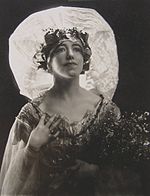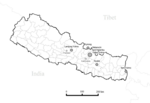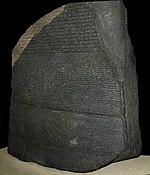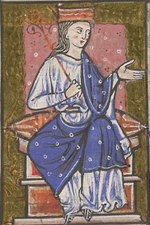WikiJournal of Humanities
 From Wikiversity - Reading time: 12 min
From Wikiversity - Reading time: 12 min
WikiJournal of Humanities
Open access • Publication charge free • Public peer review • Wikipedia-integrated
|
The WikiJournal of Humanities is a journal devoted to the humanities, arts, and social sciences in their broadest sense. It is part of the larger WikiJournal publishing group. Its function is to put articles through academic peer review for dual-publication as a stable, citable version in the journal, and as living documents in Wikipedia and other Wikimedia projects.
VOLUME 5 (2023)
ISSUE 1
Current issue
Author: SN54129
The Loveday of 1458 (also known as the Annunciation Loveday) was a ritualistic reconciliation between warring factions of the English nobility that took place at St Paul's Cathedral on 25 March 1458. Following the outbreak of the Wars of the Roses in 1455, it was the culmination of lengthy negotiations initiated by King Henry VI to resolve the lords' rivalries. English politics had become increasingly factional during his reign, and was exacerbated in 1453 when he became catatonic. This effectively left the government leaderless, and eventually the King's cousin, and at the time heir to the throne, Richard, Duke of York, was appointed Protector during the King's illness. Alongside York were his allies from the politically and militarily powerful Neville family, led by Richard, Earl of Salisbury, and his eldest son, Richard, Earl of Warwick. When the King returned to health a year later, the protectorship ended but partisanship within the government did not. [...] Supporters of King Henry and his Queen, Margaret of Anjou, have been loosely called "Lancastrians", the King being head of the House of Lancaster, while the duke and his party are considered "Yorkists", after his title of Duke of York. By the 1450s, York felt increasingly excluded from government, and, in May 1455—possibly fearing an ambush by his enemies—led an army against the King at the First Battle of St Albans. There, in what has been called more of a series of assassinations than a battle, the personal enemies of York and the Nevilles—the Duke of Somerset, the Earl of Northumberland, and Lord Clifford—perished. In 1458 the King attempted to unite his feuding nobles with a public display of friendship under the auspices of the Church at St Paul's Cathedral. Following much discussion and negotiation, and amid the presence of large, armed, noble retinues which almost led to another outbreak of war, a compromise was announced. To celebrate, a procession was held by all the major participants, who walked hand-in-hand from Westminster Palace to St Paul's Cathedral. Queen Margaret was partnered with York, and other adversaries were paired off accordingly, and the sons of the dead Lancastrian lords took their fathers' places. Certain reparations were ordained, all by the Yorkist lords, who for their part accepted full responsibility for the Battle of St Albans. They were ordered to make payments to the dead lords' widows and sons, and masses were paid for the souls of all who had died. Contemporaries varied in their views of the accord. Some wrote verses expressing hope that it would lead to a new-found peace and prosperity; others were more pessimistic as to its value. In the long run, the King's Loveday and its agreements had no long-lasting benefit. Within a few months, petty violence between the lords had broken out again and, within the year, York and Lancaster faced each other at the Battle of Blore Heath. Historians debate who—if anyone—actually gained from the 1458 Loveday. On the one hand, the crown publicised its role as the ultimate court of appeal but, conversely, although the Yorkists were bound to pay large sums in compensation, this was done with money already owed by the government. Fundamentally, factional discord was highlighted on the public stage, and the war it was intended to prevent was only deferred. doi: 10.15347/WJH/2023.001
VOLUME 4 (2021)
ISSUE 1
Previous issue
Author: Bassem Fleifel
Osman I. or Osman Bay (full form: Abū al-mulūk al-Sulṭān al-ghāzī Fakhr al-Dīn QaraʻUthmān Khān al-awwal bin Ertuğrul bin Sulaymān Shāh al-qayawi al-Turkumānī), was the leader of the Kayı Turkic clan, one of the border governors for the Sultanate of Rûm, and the founder of the Ottoman dynasty that ruled over the Balkans, Anatolia, the Levant, and North Africa for 600 years until it expired with the establishment of the Turkish Republic in 1922.
doi: 10.15347/WJH/2021.001
VOLUME 3 (2020)
ISSUE 1
Previous issue
Author: I-Wen Su
Abū al-Faraj ʿAlī b. al-Ḥusayn b. Muḥammad b. Aḥmad b. al-Ḥaytham al-Umawī al-Iṣfahānī (died after 356AH/967CE) was a litterateur, genealogist, poet, musicologist, scribe, and boon companion in the tenth century, mainly based in Baghdad. He is best known as the author of Kitāb al-Aghānī (“The Book of Songs”), a unique work which includes abundant information about the earliest attested periods of Arabic music (from the seventh to the ninth centuries) and the lives of poets and musicians from the pre-Islamic period to al-Iṣfahānī’s time. Given his contribution to the documentation of the history of Arabic music, al-Iṣfahānī is characterised by Sawa as “a true prophet of modern ethnomusicology”.
doi: 10.15347/WJH/2020.001
VOLUME 2 (2019)
ISSUE 1
Previous issue
Author: Hannah Holland
Hilda Rix Nicholas (née Rix, later Wright, 1 September 1884 – 3 August 1961) was an Australian artist. Born in the Victorian city of Ballarat, she studied under a leading Australian Impressionist, Frederick McCubbin, at the National Gallery of Victoria Art School from 1902 to 1905 and was an early member of the Melbourne Society of Women Painters and Sculptors. Following the death of her father in 1907, Rix, her only sibling Elsie and her mother travelled to Europe where she undertook further study, first in London and then Paris. Her teachers during the period included John Hassall, Richard Emil Miller and Théophile Steinlen. [...] After travelling to Tangier in 1912, Rix held several successful exhibitions of her work, with one drawing, Grande marche, Tanger, purchased by the French government. She was one of the first Australians to paint post-impressionist landscapes, was made a member of the Société des Peintres Orientalistes Français, and had works hung in the Paris Salon in 1911 and 1913. The family evacuated from France to England after the outbreak of World War I. A period of personal tragedy followed, as Rix's sister died in 1914, then her mother in 1915. In 1916 she met and married George Matson Nicholas, only to be widowed the next month when he was killed on the Western Front. Returning to Australia in 1918, Rix Nicholas once more took up professional painting, and held an exhibition of over a hundred works at Melbourne's Guild Hall. Many sold, including In Picardy, purchased by the National Gallery of Victoria. Following a period painting in rural locations in the early 1920s, Rix Nicholas returned to Europe. A 1925 exhibition in Paris led to the sale of her work In Australia to the Musée du Luxembourg, followed by an extensive tour of her paintings around regional British art galleries. Other exhibitions, such as the International Society of Sculptors, Painters and Gravers, and the Royal Academy of Arts, both in London, soon hosted her work. She was made an Associate of the Société Nationale des Beaux-Arts after several of her works were included in its 1926 Spring exhibition in Paris. In 1926, Rix Nicholas returned to Australia, and in 1928 she married Edgar Wright, whom she had met during her travels in the early 1920s. The couple settled at Delegate, New South Wales; their only child, a son named Rix Wright, was born in 1930. Though she continued to paint significant works including The Summer House and The Fair Musterer, Rix Nicholas, a staunch critic of modernism and disdainful of emerging major artists such as Russell Drysdale and William Dobell, grew out of step with trends in Australian art. Her pictures followed a conservative modern style, portraying an Australian pastoral ideal, and reviews of her exhibitions grew more uneven. She held her last solo show in 1947. Rix Nicholas remained at Delegate until her death in 1961. Her works are held in most major Australian collections, including the Art Gallery of South Australia, Australian War Memorial, National Gallery of Australia, National Gallery of Victoria, and the Queensland Art Gallery. doi: 10.15347/WJH/2019.004
Author: Christine Meyer
The themes encompassed in African-American writer Maya Angelou's seven autobiographies include racism, identity, family, and travel. Angelou (1928–2014) is best known for her first autobiography, the critically acclaimed I Know Why the Caged Bird Sings (1969). The rest of the books in her series are Gather Together in My Name (1974), Singin' and Swingin' and Gettin' Merry Like Christmas (1976), The Heart of a Woman (1981), All God's Children Need Traveling Shoes (1986), A Song Flung Up to Heaven (2002), and Mom & Me & Mom (2013). [...] Beginning with Caged Bird and ending with her final autobiography, Angelou uses the metaphor of a bird (which represents the confinement of racism and depression) struggling to escape its cage, as described in the Paul Laurence Dunbar poem "Sympathy". Angelou's autobiographies can be placed in the African-American literature tradition of political protest. Their unity underscores one of Angelou's central themes: the injustice of racism and how to fight it. According to scholar Pierre A. Walker, all of Angelou's books describe "a sequence of lessons about resisting racist oppression". In the course of her autobiographies, her views about Black-white relationships changed and she learned to accept different points of view. Angelou's theme of identity was established from the beginning of her autobiographies, with the opening lines in Caged Bird, and like other female writers in the late 1960s and early 1970s, she used the autobiography to reimagine ways of writing about women's lives and identities in a male-dominated society. Her original goal was to write about the lives of Black women in America, but it evolved in her later volumes to document the ups and downs of her own personal and professional life. The theme of family and family relationships—from the character-defining experience of Angelou's parents' abandonment in Caged Bird to her relationships with her son, husbands, friends, and lovers—are important in all of her books. As in American autobiography generally and in African-American autobiography specifically, which has its roots in the slave narrative, travel is another important theme in Angelou's autobiographies. Scholar Yolanda M. Manora called the travel motif in Angelou's autobiographies, beginning in Caged Bird, "a central metaphor for a psychic mobility". Angelou's autobiographies "stretch time and place", from Arkansas to Africa and back to the US, and span almost forty years, beginning from the start of World War II to the assassination of Martin Luther King, Jr. doi: 10.15347/WJH/2019.003
Author: Lauren Gawne
Yolmo is a Tibeto-Burman language spoken in Nepal. Also known as Helambu Sherpa, it is a Tibetic language. This article gives an overview of the language, including information about the dialects spoken, history of documentation, and a grammatical overview. The grammatical overview brings together work on different dialects, providing an outline of the sound system, noun phrase, verb phrase and clause structure.
doi: 10.15347/WJH/2019.002
Author: Andrew Dalby
The Rosetta Stone (British Museum EA24) is a granodiorite stele, found in 1799, inscribed with three versions of a decree issued at Memphis in 196 BC during the Ptolemaic dynasty on behalf of King Ptolemy V. The top and middle texts are in Ancient Egyptian using hieroglyphic and demotic scripts, respectively, while the bottom is in Ancient Greek. As the decree has only minor differences between the three versions, the Rosetta Stone proved to be the key to deciphering Egyptian hieroglyphs. [...] The stone, carved in black granodiorite during the Hellenistic period, is believed to have originally been displayed within a temple, possibly at nearby Sais. It was probably moved in Late Antiquity or during the Mameluk period, and was eventually used as building material in the construction of Fort Julien near the town of Rashid (Rosetta) in the Nile Delta. It was rediscovered there in July 1799 by a French soldier, Pierre-François Bouchard, during the Napoleonic campaign in Egypt. It was the first Ancient Egyptian bilingual text recovered in modern times, and it aroused widespread public interest with its potential to decipher this previously untranslated hieroglyphic script. Lithographic copies and plaster casts began circulating among European museums and scholars. Meanwhile, British troops defeated the French in Egypt in 1801, and the original stone came into British possession under the Capitulation of Alexandria and was transported to London. It has been on public display at the British Museum almost continuously since 1802, and is the most-visited object there. Study of the decree was already under way when the first full translation of the Greek text appeared in 1803. It was 20 years, however, before the transliteration of the Egyptian scripts was announced by Jean-François Champollion in Paris in 1822; it took longer still before scholars were able to read Ancient Egyptian inscriptions and literature confidently. Major advances in the decoding were recognition that the stone offered three versions of the same text (1799); that the demotic text used phonetic characters to spell foreign names (1802); that the hieroglyphic text did so as well, and had pervasive similarities to the demotic (Thomas Young, 1814); and that, in addition to being used for foreign names, phonetic characters were also used to spell native Egyptian words (Champollion, 1822–1824). Ever since its rediscovery, the stone has been the focus of nationalist rivalries, including its transfer from French to British possession during the Napoleonic Wars, a long-running dispute over the relative value of Young and Champollion's contributions to the decipherment, and demands for the stone's return to Egypt. Three other fragmentary copies of the same decree were discovered later, and several similar Egyptian bilingual or trilingual inscriptions are now known, including three slightly earlier Ptolemaic decrees (the Decree of Alexandria in 243 BC, the Decree of Canopus in 238 BC, and the Memphis decree of Ptolemy IV, c. 218 BC). The Rosetta Stone is, therefore, no longer unique, but it was the essential key to modern understanding of Ancient Egyptian literature and civilisation. The term Rosetta Stone is now used in other contexts as the name for the essential clue to a new field of knowledge. doi: 10.15347/WJH/2019.001
VOLUME 1 (2018)
ISSUE 1
Previous issue
Author: Dudley Miles
Æthelflæd, Lady of the Mercians (c. 870 – 12 June 918), ruled Mercia in the English Midlands from 911 until her death. She was the eldest daughter of Alfred the Great, king of Anglo-Saxon Wessex, and his wife Ealhswith. Æthelflæd was born around 870 at the height of the Viking invasions of England. By 878 most of England was under Danish Viking rule, East Anglia and Northumbria having been conquered, and Mercia partitioned between the English and the Vikings, but in that year Alfred won a crucial victory at the Battle of Edington. Soon afterwards the English-controlled western half of Mercia came under the rule of Æthelred, Lord of the Mercians, who accepted Alfred's overlordship. Alfred adopted the title King of the Anglo-Saxons, claiming to rule all English people not living in areas under Viking control. In the mid-880s, Alfred sealed the strategic alliance between the surviving English kingdoms by marrying Æthelflæd to Æthelred. [...] Æthelred played a major role in fighting off renewed Viking attacks in the 890s, together with Æthelflæd's brother, the future King Edward the Elder. Æthelred and Æthelflæd fortified Worcester, gave generous donations to Mercian churches and built a new minster in Gloucester. Æthelred's health probably declined early in the next decade, after which it is likely that Æthelflæd was mainly responsible for the government of Mercia. Edward had succeeded as King of the Anglo-Saxons in 899, and in 909 he sent a West Saxon and Mercian force to raid the northern Danelaw. They returned with the remains of the royal Northumbrian saint, Oswald, which were translated to the new Gloucester minster. Æthelred died in 911 and Æthelflæd then ruled Mercia as Lady of the Mercians. The accession of a female ruler in Mercia is described by the historian Ian Walker as "one of the most unique events in early medieval history". Alfred had begun building a network of fortified burhs and in the 910s Edward and Æthelflæd embarked on a programme of extending them. Among the towns where she built defences were Bridgnorth, Tamworth, Stafford, Warwick, Chirbury and Runcorn. In 917 she sent an army to capture Derby, the first of the Five Boroughs of the Danelaw to fall to the English, a victory described by Tim Clarkson as "her greatest triumph". In 918 Leicester surrendered without a fight. Shortly afterwards the Viking leaders of York offered her their loyalty, but she died on 12 June 918 before she could take advantage of the offer, and a few months later Edward completed the conquest of Mercia. Æthelflæd was succeeded by her daughter Ælfwynn, but in December Edward took personal control of Mercia and carried Ælfwynn off to Wessex. Historians disagree whether Mercia was an independent kingdom under Æthelred and Æthelflæd but they agree that Æthelflæd was a great ruler who played an important part in the conquest of the Danelaw. She was praised by Anglo-Norman chroniclers such as William of Malmesbury, who described her as "a powerful accession to Edward's party, the delight of his subjects, the dread of his enemies, a woman of enlarged soul". According to Pauline Stafford, "like ... Elizabeth I she became a wonder to later ages". In Nick Higham's view, medieval and modern writers have been so captivated by her that Edward's reputation has suffered unfairly in comparison. doi: 10.15347/WJH/2018.001
We're just starting up and there's plenty to do. If you want to contribute, either content, as a peer reviewer or with the documentation and organization, join us! If you're interested in joining the editorial board that runs the journal, you can apply here.
|

WikiJournal of Humanities
www.WikiJHum.org On social media
|
 KSF
KSF








